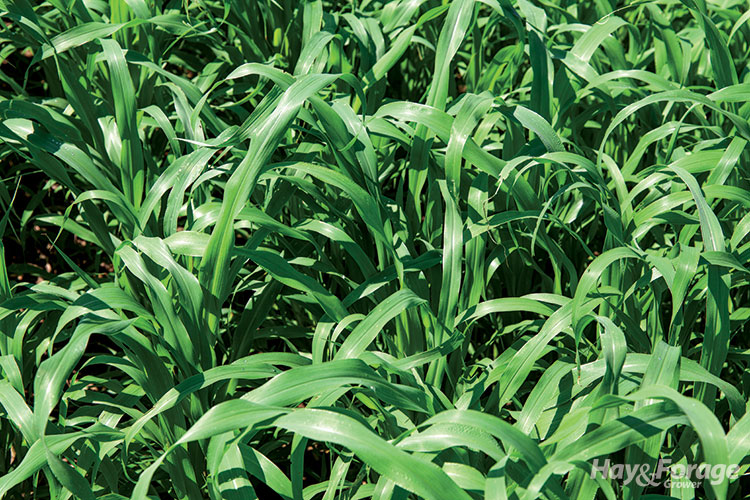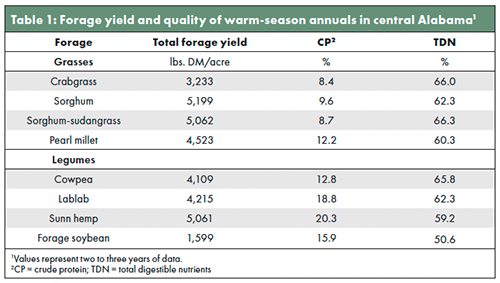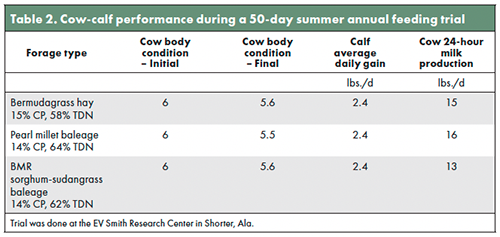Summer annual forages can cure many ills |
| By Leanne Dillard, Josh Elmore, and Kim Mullenix |
|
|
|
Dillard, Elmore, and Mullenix are an extension forage specialist, regional extension agent, and extension beef cattle specialist, respectively, with Auburn University.  Summer annuals are fast-growing, high-quality forages that can be used to supplement tall fescue systems during the summer forage slump. They also complement bahiagrass and bermudagrass for producers needing a higher quality forage during the summer. Bermudagrass, bahiagrass, and dallisgrass are excellent warm-season perennial options for maintaining cows and cow-calf pairs during the summer months in the Southeast. They are moderate to high yielding with low to moderate quality but still usually meet the nutritional demands for mature cows. For managing growing animals such as stockers or replacement heifers, lactating dairy cows, or mature females that just need to put on more condition, warm-season perennial forages are not sufficient in energy and protein and supplementation is needed. Summer annuals can be a good option to graze, limit graze, or to harvest as baleage for use during the winter. They are higher in forage quality than warm-season perennials while typically producing similar forage yields. Summer annuals include forages such as forage sorghum, millets, crabgrass, and a variety of legume species. They can provide highly productive and quality forage during times when perennials are not as productive, can be used for emergency forage during periods of drought, and provide superior forage quality for forage-based stocker and finishing operations during the summer months. Summer annual forages are highly productive in a very short amount of time. When rain delays planting of summer crops by several weeks, these forages can still be grazed in as little as 60 days after planting. They also provide grazable forage during a time when tall fescue is dormant (June to September). Many options exist There are many different species and varieties of summer annual forages. Sorghum, sudangrass, and sorghum-sudangrass hybrids have been researched and used extensively throughout the Southeast. Millets, especially pearl millet, and crabgrass are also popular, with pearl millet being more drought tolerant compared with the sorghums and sudangrasses. Teff is another summer annual grass option; however, little research has been conducted on its use in the South. Summer annual tropical legumes can also be used, but breeding in this area has been limited, so few varieties are available. These legumes include sunn hemp, annual lespedeza, cowpea, lablab, and velvet bean. Sorghum, sudangrass, and sorghum-sudangrass are high yielding, often topping 5 tons of dry matter (DM) per acre, and have high quality with about 17% crude protein and 58% total digestible nutrients (TDN). Pearl millet is productive under drought conditions and can tolerate lower soil pH than sorghums. It is slower maturing, making it easier to manage under grazing, and its thinner stems make it less difficult to dry. Pearl millet will yield 2 to 6 tons of DM per acre with 12% crude protein and 55% TDN. There are many millet species (for example, browntop, foxtail, and Japanese); however, pearl millet varieties are more common for use in forage systems. Crabgrass is another productive, drought tolerant summer annual option. Crabgrass can yield 2 to 5 tons of DM per acre and is about 14% crude protein and 58% TDN. While an annual, many producers find that crabgrass is prolific at reseeding itself each year, which reduces establishment costs. Less research is available regarding summer annual legumes. While not grazing tolerant, these species can be used in a mixture with summer annual grasses to enhance digestibility and crude protein. Research on forage yield and quality of several summer annual grasses and legumes has recently been conducted in central Alabama, and the results are summarized in Table 1.  Harvesting dry is difficult It is often necessary to harvest and store summer annuals for use during the winter or fall transition. Summer annual grasses are high in moisture and typically have thick stems, making them difficult to wilt and harvest as dry hay; however, the high quality and sugar content of summer annuals make them easy to ensile as chopped forage or baleage. They can also be grazed under intensive management. A feeding evaluation with cow-calf pairs at Auburn University highlighted animal performance and forage quality in a fall-calving herd using summer-annual baleage during the winter-feeding period. Tifleaf 3 pearl millet and AGS6402 sorghum-sudangrass (a brown midrib [BMR] hybrid) were planted in early June 2016 and harvested three times during the study. Forage harvests generally followed a four-week regrowth interval during the growing season. Cows and calves were fed either pearl millet baleage, sorghum-sudangrass baleage, or Tifton 85 bermudagrass hay during a 50-day feeding trial. Animal performance during the feeding trial is shown in Table 2. All cows maintained a body condition score of 5.5 to 6 during the feeding period, which coincided with peak lactation. The average milk production by each cow during a 24-hour period was 15 pounds and was similar across the forage diets.  All calves had an average daily gain of 2.4 pounds per day. Forage TDN concentration was 58%, 62%, and 64% for the bermudagrass hay, BMR sorghum-sudangrass, and pearl millet baleage, respectively. Crude protein ranged from 14% to 15% for all of the warm-season forages used in the trial, which illustrates the high quality of the forages evaluated in this study. These data indicate that summer annual baleage can serve as a high-quality alternative to dry hay to support animal production during the peak of the production cycle. Always conduct a forage analysis to determine if additional supplemental feed is needed to support performance, monitor cow body condition score after calving, and make nutritional adjustments as needed to achieve animal performance targets. Consider the production costs of a summer-annual baleage system and evaluate if there are potential savings in forage waste, labor, and animal performance. A few downsides Sorghum, sudangrass, and sorghum-sudangrass can cause prussic acid poisoning in the fall following a frost or freeze event. When a killing frost is forecasted, animals must be removed from the field for seven to 10 days to allow prussic acid levels to decline. Pearl millet and crabgrass do not contain prussic acid, but all summer annual grasses have the potential of causing nitrate toxicity. After a drought-ending rain or extended cloudy weather, allow forages to stand ungrazed or harvested for one week until nitrate levels have declined. A nitrate test can be conducted by any forage lab to determine the exact concentrations in the forage. Sugarcane aphids are a pest of sorghum and sorghum-sudangrass hybrids that have recently become a concern in the Southeastern U.S. Sugarcane aphids suck sap out of the plant’s xylem, reducing the nutrients available to the plant. Also, a black, sooty mold develops on the leaves, which may reduce the plant’s ability for photosynthesis and can make a mess of harvesting equipment. As a result, sugarcane aphids can reduce both forage quality and harvesting efficiency. A recent study at Auburn University showed that planting sorghum-sudangrass in mixtures with crabgrass and cowpea reduced the overall sugarcane aphid pressure per acre but increased the number of sugarcane aphids per sorghum-sudangrass plant. The study showed that forage yields were not different among the three-way mixture and the nontreated sorghum-sudangrass, but both had about a 27% yield reduction compared to treated sorghum-sudangrass. Summer annual grasses work well in mixtures with each other and with summer annual legumes. While not as productive as the grasses, summer annual legumes are highly nutritious and can boost overall forage quality compared with grass-only pastures. When planning your forage system, incorporating summer annuals and summer annual mixtures can be useful to either bridge the tall fescue gap or to meet the nutrient requirements of stocker and finishing cattle. Committing 10% to 15% of your perennial-based forage system to annual production, both winter and summer, can provide some flexibility and insurance against unfavorable weather conditions. This article appeared in the March 2022 issue of Hay & Forage Grower on pages 10 and 11. Not a subscriber? Click to get the print magazine. |
